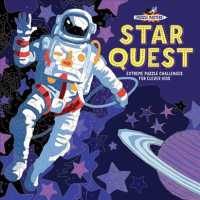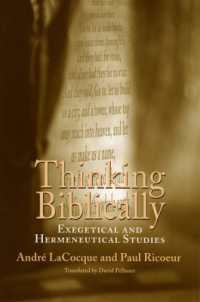Full Description
Prepare early childhood educators to teach all children in inclusive settings with the fourth edition of this bestselling guidebook--enhanced with new content, new topics, and more tools for planning effective instruction.Like the groundbreaking previous editions, this updated Building Blocks guide gives pre- and inservice teachers three types of practical, evidence-based inclusion strategies: curriculum modifications, embedded learning opportunities, and child-focused instructional strategies. Educators will learn how to apply these three strategies for the benefit of all children; review the latest research that supports the Building Blocks model; and find ready-to-use tips and guidance on key topics, from fostering friendships to promoting positive behavior. New reproducible forms support planning and assessment, and seven training modules make it easy to teach the Building Blocks framework in college courses and professional development sessions.
Equally useful as a student-friendly textbook and a go-to guide for practicing educators, this is a resource readers will return to again and again for proven, easy-to-use strategies that support all young learners.
What's New
All chapters updated
New chapter on Ongoing Assessment and Instructional Decision-Making
New chapter on Implementing the Building Blocks Framework
8 new checklists and planning forms to support implementation
New section on the impact of implicit bias on teachers' perception of challenging behavior
Expanded content on key topics such as collaboration, curriculum modifications, friendships and social relationships
Updated vignettes, terms, resources, and references
With 7 Training Modules: Using the Building Blocks framework; Conducting ongoing child assessment; Planning for the individual child; Using visuals to support learning; Applying the Building Blocks framework to math and science; Applying the framework to challenging classroom behavior; Extending the framework to infants and toddlers
Contents
Section I: Using the Building Blocks Framework
This section will maintain the same organization as the third edition.
Chapter 1: Introduction
This chapter will be revised and updated. We will position Building Blocks within the umbrella of multi-tiered systems of support. We will review and revise the vignettes to make sure that they "ring true" in terms of culture and diversity as well as the range of early childhood service delivery environments.
Chapter 2: Evidence-Based Practice and the Building Blocks Framework
This chapter will be revised and updated to include up-to-date references. We will strengthen the description of the bottom block - foundation. We will incorporate current thinking and research around diversity and equity.
Chapter 3: Keys to Collaboration
This chapter will be revised and updated. We will pay particular attention to collaboration across early childhood sectors and incorporate examples/vignettes to show effective collaboration strategies. Similarly, we will carefully review and revise how we show collaboration with families. Since the topics that were identified by reviewers had, in fact, been added in the third edition of the book, we will consider some formatting changes and/or additional examples to better highlight this content.
Chapter 4: Getting Started with Building Blocks
The organization of this chapter will remain the same. We will review and revise as needed based on reviewer comments and our own recent experiences with programs who are adopting Building Blocks. We will do a better job at clarifying how UDL fits within the Building Blocks framework.
Section II: Teaching Strategies
The organization of this section will remain the same with additions as noted below.
Chapter 5: Curriculum Modifications
We will do a thorough review of the curriculum modifications with special attention to culture, diversity, age range, and service delivery options.
We will add a sub-section on how to identify an appropriate modification, how to collect data on its usefulness, and how to make changes if needed.
Chapter 6: Embedded Learning Opportunities
This chapter will be reviewed and revised to improve clarity, ensure representation, and to show how embedded learning opportunities are used across curricular domains.
We will add a sub-section on ongoing assessment and instructional decision making as related to embedded teaching and learning.
Chapter 7: Child-Focused Instructional Strategies
This chapter will be reviewed and revised to ensure representation, and to show how child-focused instructional strategies are used across curricular domains. We will add more specific content related to children with significant disabilities. We will discuss child-focused instructional strategies in related to the concept of specially designed instruction.
We will add a sub-section on ongoing assessment and instructional decision making related to use of child-focused instructional strategies.
Chapter 8: Assessment and Instructional Decision Making (new chapter; working title)
We propose this new chapter. This chapter will focus on the importance of assessment to monitor child progress and to improve teaching and learning. We will use a visual to capture the connection of assessment and teaching, show simple strategies to incorporate ongoing data collection into teaching, and share strategies for making good instructional decisions. This content will be based on our own experiences, research, and interactions with many early childhood programs. As with other chapters, our intention is to write this in a straightforward manner and use examples/vignettes to bring ongoing assessment to life.
Section III: Important Topics Related to the Building Blocks Framework
It is likely that the order of these chapters will change as we work on them. The current chapter 9 - Acquiring and Using Knowledge Including Language and Early Literacy will be omitted. A new chapter on Implementing the Building Blocks framework will be added. All chapters will be reviewed and revised in terms of equity and representation (diversity, range of service delivery options, children from toddlers through kindergarten).
Chapter x: Becoming More Independent
This chapter will be reviewed and updated. We expect to include information on transition to kindergarten here. We also expect to include information on self-determination in this chapter.
Chapter x: Friendships and Social Relationships
This chapter will be reviewed and updated.
Chapter x: Developmentally Appropriate Classroom Behavior
This chapter will be renamed to capture the range of service options - child care centers, family child care homes, play groups as well as classrooms. Chapter content will be reviewed and updated.
Chapter x: Implementing the Building Blocks Framework
This new chapter will focus on adopting and establishing the Building Blocks framework across various early childhood contexts. The chapter will draw from what we know from implementation science as well as our own work with programs and systems. The chapter will include practical, useful supports such as supervisor (director) guides and checklists.
Chapter 13: Concluding Thoughts
This chapter will be updated based on the revisions to the previous chapters.
References
The references will be updated.
Appendix A: Blank Forms
We will continue to make the blank forms available.
Appendix B: Additional Resources
We will completely update this section.
Supplemental Materials: Professional Developmental Modules








